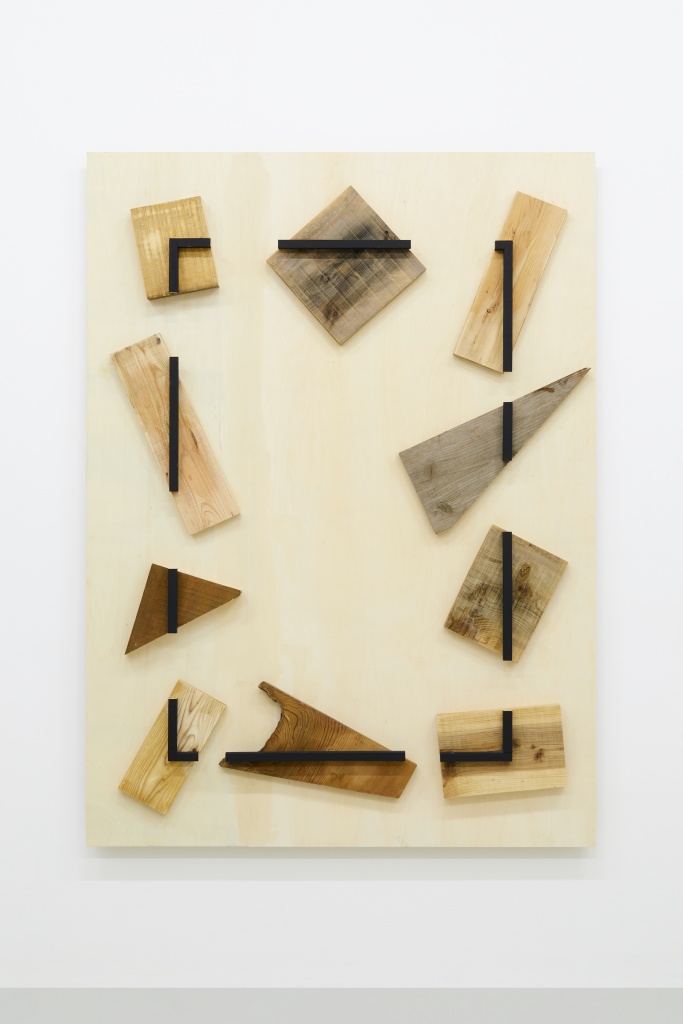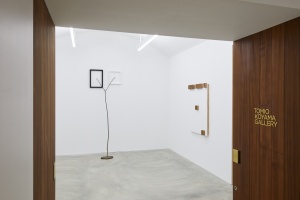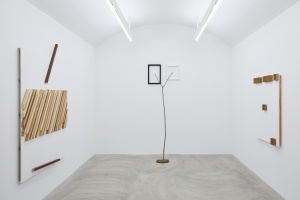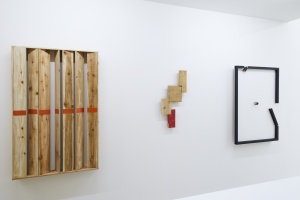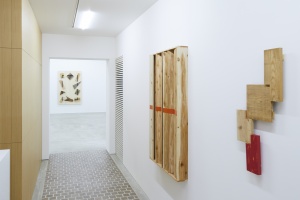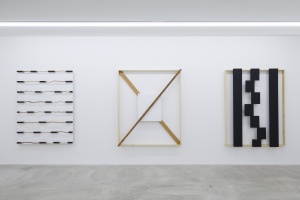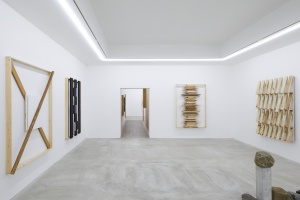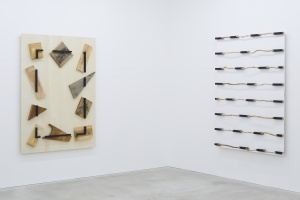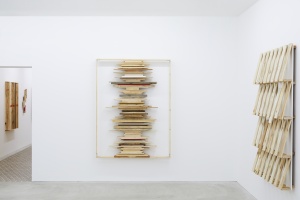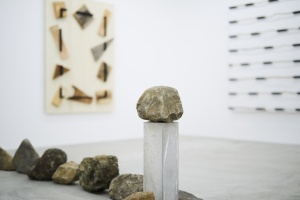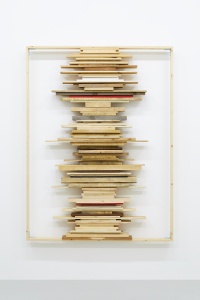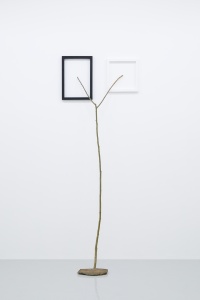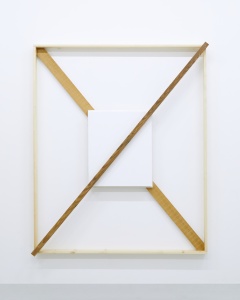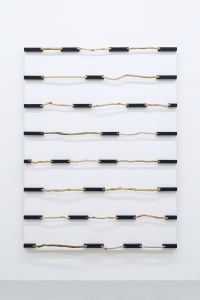Tomio Koyama Gallery is pleased to present Expanded Self-Space, a solo exhibition with Kishio Suga featuring a selection of approximately 20 latest works by the artist.
Kishio Suga is a central member of the art movement Mono-ha that took place from the late 1960s to the 1970s, and has continued to develop his own distinct practice as one of the leading figures in Postwar Japanese art. Suga engages in various approaches concerning the relationships between “things” such as stones, trees, metals, and that of space, based on his unique philosophy that resonates with Eastern thoughts like Indian philosophy. In doing so, he produces works that are themselves manifestations of the profound presence harbored within “things.” Even in recent years when the reevaluation of Mono-ha has been gaining much international recognition, Suga persists in further deepening his contemplation, with his unfaltering passion and enthusiasm for his practice serving to define the presentness of his work.
【Recent International Activity and Recognition】
Since his first solo exhibition in 1968, Suga has presented work on over 370 occasions in numerous exhibitions both within Japan and abroad. Recent years in particular have seen remarkable developments and achievements in his career. In 2016 he held solo exhibitions at Pirelli Foundation’s HangarBiocca in Milan and Dia: Chelsea New York, in addition to a two-person exhibition with Karla Black at The Scottish National Gallery of Modern Art in Edinburgh. He was selected for the 57th Venice Biennale, “VIVA ARTE VIVA” in 2017, receiving high acclaim for Law of Situation in which he recreated of one of his most important early works in the form of an installation floating on water. In that same year Suga participated in the group exhibition “Japanorama: New Vision of JAPAN from 1970,”curated by Yuko Hasegawa that was held at the Centre Pompidou-Metz in France.
Suga’s works have been newly added to the collections of the Centre Pompidou and Dia: Chelsea this year, and are also housed in numerous prominent museums throughout the world including the Tate Modern, Dallas Museum of Art, M+, Guggenheim Abu Dhabi, The Scottish National Gallery of Modern Art, and the Museum of Contemporary Art, Tokyo.
Throughout his practice Suga has continued to thoroughly reconsider the conventional concepts of recognition, perceiving “things” not simply as “solid bodies” or “objects” determined by human subjectivity but instead regarding stones and people as both the same in terms of substance, thereby believing things, people, and thoughts to be equal. Suga’s work had been met with criticism in his first overseas exhibition at “The 8th Paris Biennale,” with questions raised regarding their definition as works of art due to subject-object dualism being the mainstream discourse at the time in Europe. His exhibitions in recent years have been important opportunities that bear testimony to how his views on the world were truly understood and evaluated in an international context.
【About the Exhibition: Expanded Self-Space】
The exhibition Expanded Self Space marks Kisho Suga’s seventh exhibition at Tomio Koyama Gallery since his previous solo exhibition Divided Orientation of Space held in 2017, and features a selection of approximately 20 latest works. In addition, the exhibition Kishio Suga – Photographs and Videos” (May 30 – June 25, 2018) will be held concurrently at 8/ ART GALLERY / Tomio Koyama Gallery, introducing photographs and video works as well as documentary footage regarding his ongoing investigation of the “activation of existence.” A screening of the film Being and Murder (1988-99) directed and written by Suga will also take place, with his metal sculpture scheduled for presentation in the solo exhibition Released Existence on Edges (May 12 – July 4, 2018) at “The Club” art gallery in GINZA SIX.
Suga enables “things” and “things,” “things” and “space,” and “things” and “people” to connect, enclose and be interdependent on each other in different ways from how we usually perceive things to be in existence, thereby giving the impression of things as presenting new forms and even situations. Suga attempts to reveal the fundamental conditions and manner in which our world exists through a multifaceted approach that appropriates various means from three-dimensional works to two-dimensional works, photographs, and video to express that which we are “unable to see.” These series of exhibitions will serve as an invaluable opportunity to comprehensively encounter and experience the world of Suga’s work.
【About the Featured Works】
Within the text she contributed to the publication, Kishio Suga: Expanded Self-Space l Divided Orientation of Space, Mami Katakoka, chief curator of the Mori Art Museum, mentions as follows regarding the works presented in this exhibition.
The works displayed on the walls of this exhibition “Expanded Self-Space”, for instance, are clearly an extension of Suga’s sculptures and installations. An immediate painterly interpretation of these pieces just because they hang on the wall, therefore, would be problematic. One of the reasons for this can be found in the continuity of the situation. … In each of these works, however, a single portion that protrudes outward from the white region that forms the base suggests that Suga’s awareness is not constrained to a specific framework or domain: what is alluded to here is the possibility of establishing a connection and expanding to the surrounding space.
(Mami Kataoka “Probing ‘situations’ ”, in Kishio Suga Expanded Self-Space │ Divided Orientation of Space, Tomio Koyama Gallery, 2018)
Furthermore, Suga states as follows in his statement for this exhibition.
“…When expressing “things – a work” by taking out various things from a realistic space originally occupied by things, it is indeed a problem if it becomes a state in which the things are no longer able to exist there as they had done so prior. Things that are there must exist as they are, and things that are not there must exist as not being there. To give an example, something like transporting a live fish from the sea to some place far away without it dying, is important as a necessary gesture when expressing “things.”
(Kishio Suga, “What Emerges, and Does Not Emerge,” Expanded Self-Space l Divided Orientation of Space, 2018, published by Tomio Koyama Gallery)
Suga elaborates upon the relationship between given spaces and environments as a means to establish existence, engaging in large installation works that occupy vast museum exhibition spaces in their entirety, three-dimensional works presented on walls as observed in this exhibition, and exhibitions held outdoors referred to as noten(fieldwork). Regardless of their scale, his works consistently exert influence on space in a variety of ways, attracting, transforming, and giving rise to new spaces, evoking a diverse sense of awareness towards space within viewers.
【“Things” and Space, the Interdependence of Human Spirit, and the Liberation of Consciousness】
Art critic Midori Matsui mentions as follows with regards to Suga’s work.
(Suga’s solo exhibition held at Tomio Koyama Gallery in 2015) created the opportunity … to contemplate his ideas about the liberation of human spirit through mono and (to reexamine) the possibilities of transforming the significance of mono through human “subjective perception”
(Midori Matsui “The Presence of Things, the Position of People: The Interdependence of Mind and Matter in Kishio Suga’s Artistic Practice”, Kishio Suga “Intentional Scenic Space, Tomio Koyama Gallery, 2017)
This (experience of Suga’s works) in turn conveys an unceasing feeling of freedom, when the spectator realizes the elusiveness of perception, which escapes the fines archive of knowledge.
(Midori Matsui “Approaching Kishio Suga: Methods for Capturing an Immanent World”, KISHIO SUGA-Catalogue, Tomio Koyama Gallery/Tokyo Gallery, 2006)
Suga’s works, rather than presenting a confrontation between things, space, and human spirit, indicate the supportive relationships and connections that exist between them. In doing so, they seemingly encourages us as viewers to reflect upon our own human nature regarding the way in which we perceive things and the very intentions that we harbor. Such works liberate our consciousness, and serve as an opportunity to acquire new perspectives and an activated spirit. Viewers are invited to encounter the latest works of a historical artist of our contemporary times whose practice increasingly permeates with an intense sense of energy and air of sophistication.
—————————————————————————————–
For press inquiries, please contact:
press@tomiokoyamagallery.com (Makiko Okado)
—————————————————————————————–

